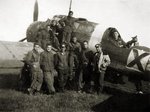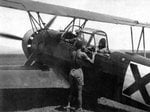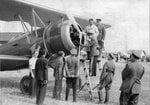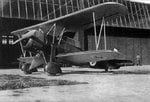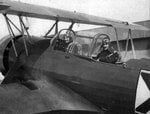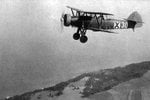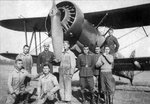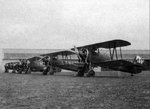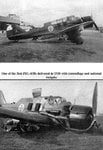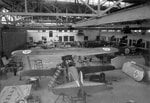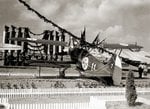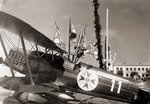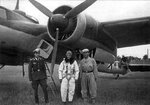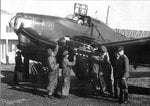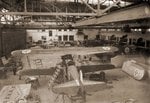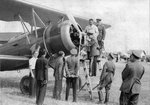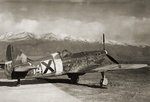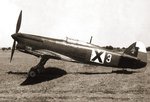November 27, 1919 the Treaty of Neuilly-sur-Seine was signed. In accordance with the treaty the Kingdom of Bulgaria was banned from operating military aircraft under any form for the next 20 years. For that reason all Bulgarian airplanes, balloons, aviation equipment, weaponry and ammunition were to be destroyed under Allied control. Under the terms of the treaty any aircraft, procured for civilian purposes, were to be bought from the countries on the winning side. The combined engine power for any airplane (including multiengined ones) was not to exceed 180 hp. In addition, the Bulgarian airspace was to be controlled by the allies and used according to the victorious countries' interests. In accordance with the treaty during 1920 no less than 70 airplanes, 110 aviation engines, 3 air balloons, 76 aviation machine guns, a number of photographic cameras and as well as other aviation equipment were destroyed at the military airfield of Bozhurishte. The seaplanes of the Bulgarian Navy were delivered by train to the same airfield and scrapped soon after that. On 5 July 1923 Bulgaria ratified the International Civil Aviation Treaty. From that moment on its air vehicles would carry a registration in the form B-Bxxx (the latter three signs being a combination of capital letters). In 1923 the first group of cadets, called "student-flyers" entered the Flying school at Vrazhdebna AF.The following year (1924) the first new airplanes were acquired. Those were machines of the Potez VIII, Caudron C.59, Henriot XD.14, Bristol 29 Tourer types; Avro 522 seaplanes (shown above) were also procured. Also in 1924 the Aeroplane Section was expanded to an Aeroflight Directorate still under the Ministry of Railways, Postal Service and Telegraph.
1925 saw the Potez XVII, Bristol Lucifer and the Macchi 2000/18 flying boats boosting the country's aircraft inventory. The Bulgarian government invited a group of German aircraft engineers, headed by the constructor Herr Hermann Winter to help establish an aviation factory.Named The State's Aeroconstruction Atelliér (more popular as DAR-Bozhurishte) the factory was initially managed by the first Bulgarian pilot to achieve an aerial victory - Mr. Marko Parvanov. The first aircraft types, produced by the plant were the "Uzounov-1" (an indigenous variant of the wartime German DFW C.V) and the DAR-2 (indigenous variant of the German Albatross C.III of the same era). Both types well-known and loved by the personnel of the former Air Troops and with Bulgarian combat service experience. A new type - the DAR-1, was also in a phase of development.
In 1928 the Ministry of War started the ambitious 10-year program for development of the military aviation (still banned by the peace treaty). Bulgaria started acquiring German, Czechoslovak and Polish airplanes.In 1934 the Aviation Regiment was renamed His Majesty's Air Troops, comprising a headquarters, with two army air groups (based at Bozhurishte and Plovdiv airfields), a training group (in Plovdiv), a maritime aquadron (at NAS Chaika, Varna) and additional operational support units. The first combat aircraft entered service in the reestablished air force in 1937 were 12 Arado Ar.65 fighters, 12 Heinkel He.51 fighters, 12 Dornier Do.11 bombers and 12 Heinkel He.45B recon planes. These machines are known as the Royal Gift, donated to the HMAT personally by Tsar (King) Boris III. In 1938 14 newly built Polish PZL.24B fighters (shown above) were acquired along with 12 PZL.43B light bombers. When the Third Reich occupied Czechoslovakia, absorbing her Czech Lands as the Protectorate of Bohemia and Moravia, her air force ceased to exist. Bulgaria used the opportunity to acquire large numbers of relatively modern aircraft at a symbolic price. 78 Avia B.534 biplane fighters, 32 Avia B.71 bombers (a license version of the Soviet SB light bomber, shown above) and 60 Letov Š.328 recon were part of the reinforcements. In less than 3 years the Air Force inventory had grown up to 478 pieces of which 135 of Bulgarian construction.
The Kingdom of Bulgaria entered World War II on the 1 March 1941 as a German ally. Under the signed treaty Bulgaria allowed the use of its territory as a staging point for the invasion of Yugoslavia and Greece and some minor logistical support. Despite the impressive inventory, Bulgaria's fighter force at the time consisted of 91 machines, with just 10 of them being of the modern Bf 109E-4 type. Further 11 were of the outdated PZL.24B; the remaining numbers were of the Avia B.534 biplane types. At the end of 1941 the inventory of His Majesty's Air Troops consisted of 609 aircraft of 40 different types.
1925 saw the Potez XVII, Bristol Lucifer and the Macchi 2000/18 flying boats boosting the country's aircraft inventory. The Bulgarian government invited a group of German aircraft engineers, headed by the constructor Herr Hermann Winter to help establish an aviation factory.Named The State's Aeroconstruction Atelliér (more popular as DAR-Bozhurishte) the factory was initially managed by the first Bulgarian pilot to achieve an aerial victory - Mr. Marko Parvanov. The first aircraft types, produced by the plant were the "Uzounov-1" (an indigenous variant of the wartime German DFW C.V) and the DAR-2 (indigenous variant of the German Albatross C.III of the same era). Both types well-known and loved by the personnel of the former Air Troops and with Bulgarian combat service experience. A new type - the DAR-1, was also in a phase of development.
In 1928 the Ministry of War started the ambitious 10-year program for development of the military aviation (still banned by the peace treaty). Bulgaria started acquiring German, Czechoslovak and Polish airplanes.In 1934 the Aviation Regiment was renamed His Majesty's Air Troops, comprising a headquarters, with two army air groups (based at Bozhurishte and Plovdiv airfields), a training group (in Plovdiv), a maritime aquadron (at NAS Chaika, Varna) and additional operational support units. The first combat aircraft entered service in the reestablished air force in 1937 were 12 Arado Ar.65 fighters, 12 Heinkel He.51 fighters, 12 Dornier Do.11 bombers and 12 Heinkel He.45B recon planes. These machines are known as the Royal Gift, donated to the HMAT personally by Tsar (King) Boris III. In 1938 14 newly built Polish PZL.24B fighters (shown above) were acquired along with 12 PZL.43B light bombers. When the Third Reich occupied Czechoslovakia, absorbing her Czech Lands as the Protectorate of Bohemia and Moravia, her air force ceased to exist. Bulgaria used the opportunity to acquire large numbers of relatively modern aircraft at a symbolic price. 78 Avia B.534 biplane fighters, 32 Avia B.71 bombers (a license version of the Soviet SB light bomber, shown above) and 60 Letov Š.328 recon were part of the reinforcements. In less than 3 years the Air Force inventory had grown up to 478 pieces of which 135 of Bulgarian construction.
The Kingdom of Bulgaria entered World War II on the 1 March 1941 as a German ally. Under the signed treaty Bulgaria allowed the use of its territory as a staging point for the invasion of Yugoslavia and Greece and some minor logistical support. Despite the impressive inventory, Bulgaria's fighter force at the time consisted of 91 machines, with just 10 of them being of the modern Bf 109E-4 type. Further 11 were of the outdated PZL.24B; the remaining numbers were of the Avia B.534 biplane types. At the end of 1941 the inventory of His Majesty's Air Troops consisted of 609 aircraft of 40 different types.




